Market Segmentation And Targeting Topic 2022
This fact sheet provides information about the registration process and topic allocation for a term paper in the subjects of Business Administration, Economics or Law. It also includes a sample topic on the legacy of Reaganomics and a coaching meeting for students.
38 Pages9979 Words40 Views
Added on 2022-09-15
Market Segmentation And Targeting Topic 2022
This fact sheet provides information about the registration process and topic allocation for a term paper in the subjects of Business Administration, Economics or Law. It also includes a sample topic on the legacy of Reaganomics and a coaching meeting for students.
Added on 2022-09-15
ShareRelated Documents
Running head: MARKET SEGMENTATION AND TARGETING
MARKET SEGMENTATION AND TARGETING: COMPARISONS OF SUCCESSFUL
MARKET AND CUSTOMER SEGMENTATION IN AFRICA
Name of the Student:
Name of the University:
Author’s Note:
MARKET SEGMENTATION AND TARGETING: COMPARISONS OF SUCCESSFUL
MARKET AND CUSTOMER SEGMENTATION IN AFRICA
Name of the Student:
Name of the University:
Author’s Note:
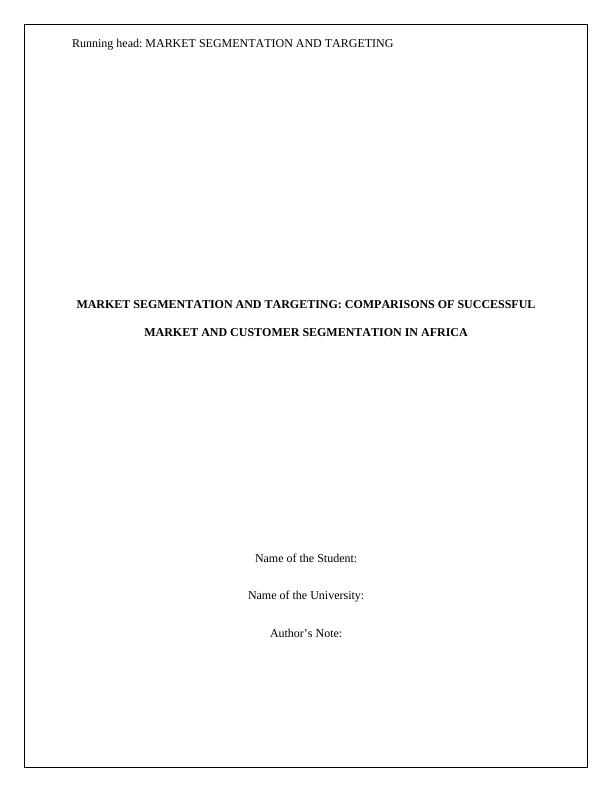
1MARKET SEGMENTATION AND TARGETING
ABSTRACT
The purpose of this study is to undertake an analysis of customer segmentation and targeting
strategies used by the airline corporations in Africa by focusing on Ethiopian Airlines, South
African Airways and Kenya Airways. The researcher for conducting this analysis had taken the
help of the pragmatic research philosophy, descriptive research design, deductive research
approach, secondary data collection method and qualitative data analysis method. The results of
the study reveal the fact that the Ethiopian Airlines targets the customer segments which avails
the low-cost carrier services offered by it. On the other hand, it is seen that the South African
Airlines, Kenya Airlines and other airline corporations of Africa focus on the customer segments
which avail the economic or the business class services offered by them. In addition to these, it is
seen that Ethiopian Airlines focuses on the attribute of cost whereas South African Airlines,
Kenya Airlines and others focus on the attribute of quality for attaining a unique position within
the African airline industry and also for influencing the buying behavior of their customers.
However, the success attained by Ethiopian Airlines clearly reveals the effectiveness of the
segmentation, targeting and positioning strategies used by it in comparison to South African
Airlines, Kenya Airlines and others which in turn had enabled it to attain competitive advantage
within the African airline industry. The study concludes by recommending the usage of
personalized advertisements for influencing the customer segments, focus the customer segment
which avails the low-cost carrier services and focusing on the attribute of cost for attaining a
unique market image.
ABSTRACT
The purpose of this study is to undertake an analysis of customer segmentation and targeting
strategies used by the airline corporations in Africa by focusing on Ethiopian Airlines, South
African Airways and Kenya Airways. The researcher for conducting this analysis had taken the
help of the pragmatic research philosophy, descriptive research design, deductive research
approach, secondary data collection method and qualitative data analysis method. The results of
the study reveal the fact that the Ethiopian Airlines targets the customer segments which avails
the low-cost carrier services offered by it. On the other hand, it is seen that the South African
Airlines, Kenya Airlines and other airline corporations of Africa focus on the customer segments
which avail the economic or the business class services offered by them. In addition to these, it is
seen that Ethiopian Airlines focuses on the attribute of cost whereas South African Airlines,
Kenya Airlines and others focus on the attribute of quality for attaining a unique position within
the African airline industry and also for influencing the buying behavior of their customers.
However, the success attained by Ethiopian Airlines clearly reveals the effectiveness of the
segmentation, targeting and positioning strategies used by it in comparison to South African
Airlines, Kenya Airlines and others which in turn had enabled it to attain competitive advantage
within the African airline industry. The study concludes by recommending the usage of
personalized advertisements for influencing the customer segments, focus the customer segment
which avails the low-cost carrier services and focusing on the attribute of cost for attaining a
unique market image.
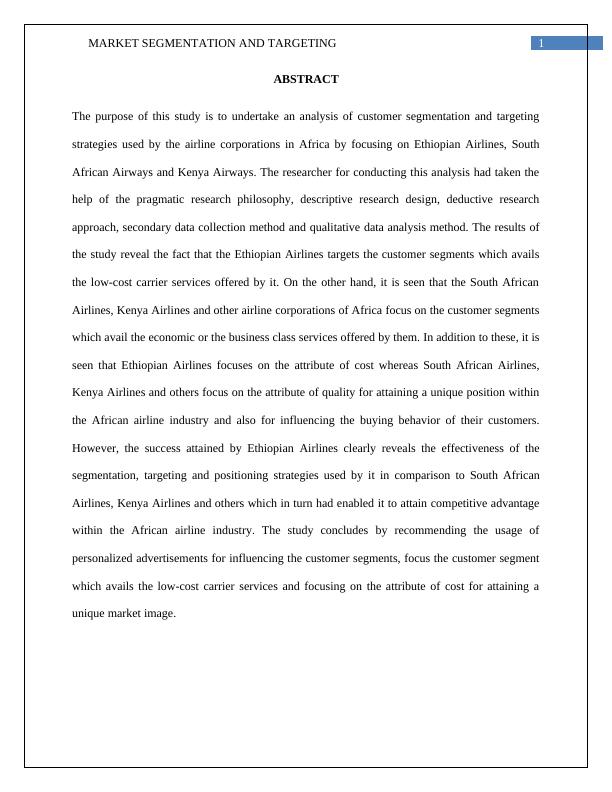
2MARKET SEGMENTATION AND TARGETING
ACKNOWLEDGEMENT
I would firstly like to thank my Professor for offering me the opportunity to complete this study
on the topic “Market Segmentation and Targeting: Comparisons of Successful Market and
Customer Segmentation in Africa”. Furthermore, I would also like to thank my Supervisor for
helping me during each of the stages of this study and whom I would not have been able to
complete this study.
Lastly, I would like to thank my friends and family members for their unwavering support and
encouragement.
Thank You
-----------------------------------------------------------
(Name of the Researcher)
ACKNOWLEDGEMENT
I would firstly like to thank my Professor for offering me the opportunity to complete this study
on the topic “Market Segmentation and Targeting: Comparisons of Successful Market and
Customer Segmentation in Africa”. Furthermore, I would also like to thank my Supervisor for
helping me during each of the stages of this study and whom I would not have been able to
complete this study.
Lastly, I would like to thank my friends and family members for their unwavering support and
encouragement.
Thank You
-----------------------------------------------------------
(Name of the Researcher)
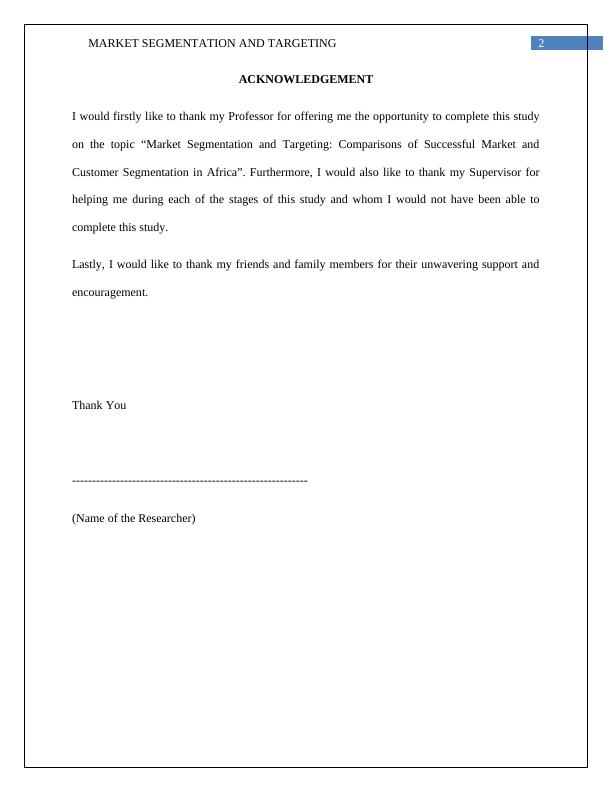
3MARKET SEGMENTATION AND TARGETING
Table of Contents
Chapter 1: INTRODUCTION.........................................................................................................6
1.1 Introduction............................................................................................................................6
1.2 Background of the Study.......................................................................................................6
1.3 Problem Statement.................................................................................................................7
1.4 Research Aim.........................................................................................................................8
1.5 Research Objectives...............................................................................................................8
1.6 Research Questions................................................................................................................8
1.7 Structure of the Study............................................................................................................9
1.8 Summary..............................................................................................................................10
Chapter 2: LITERATURE REVIEW............................................................................................11
2.1 Introduction..........................................................................................................................11
2.2 Concept of Customer Segmentation....................................................................................11
2.3 Customer Targeting.............................................................................................................13
2.4 Concept of Market Positioning............................................................................................15
2.5 Impact of Customer Segmentation and Targeting and Positioning Strategy on the growth
of the corporations.....................................................................................................................16
2.6 Literature Review................................................................................................................16
2.7 Summary..............................................................................................................................17
Chapter 3: RESEARCH METHODOLOGY.................................................................................18
Table of Contents
Chapter 1: INTRODUCTION.........................................................................................................6
1.1 Introduction............................................................................................................................6
1.2 Background of the Study.......................................................................................................6
1.3 Problem Statement.................................................................................................................7
1.4 Research Aim.........................................................................................................................8
1.5 Research Objectives...............................................................................................................8
1.6 Research Questions................................................................................................................8
1.7 Structure of the Study............................................................................................................9
1.8 Summary..............................................................................................................................10
Chapter 2: LITERATURE REVIEW............................................................................................11
2.1 Introduction..........................................................................................................................11
2.2 Concept of Customer Segmentation....................................................................................11
2.3 Customer Targeting.............................................................................................................13
2.4 Concept of Market Positioning............................................................................................15
2.5 Impact of Customer Segmentation and Targeting and Positioning Strategy on the growth
of the corporations.....................................................................................................................16
2.6 Literature Review................................................................................................................16
2.7 Summary..............................................................................................................................17
Chapter 3: RESEARCH METHODOLOGY.................................................................................18

4MARKET SEGMENTATION AND TARGETING
3.1 Introduction..........................................................................................................................18
3.2 Research Philosophy............................................................................................................18
3.3 Research Approach..............................................................................................................18
3.4 Research Design..................................................................................................................19
3.5 Data Collection Method.......................................................................................................19
3.6 Data Analysis Method.........................................................................................................20
3.7 Limitations of Study............................................................................................................20
3.8 Summary..............................................................................................................................20
Chapter 4: FINDINGS AND DISCUSSION.................................................................................22
4.1 Introduction..........................................................................................................................22
4.2 Presentation of Findings......................................................................................................22
4.3 Discussion of the Findings...................................................................................................25
4.4 Summary..............................................................................................................................28
Chapter 5: CONCLUSION AND RECOMMENDATIONS........................................................30
5.1 Conclusion...........................................................................................................................30
5.2 Recommendations................................................................................................................30
5.3 Future Scope........................................................................................................................31
References......................................................................................................................................32
3.1 Introduction..........................................................................................................................18
3.2 Research Philosophy............................................................................................................18
3.3 Research Approach..............................................................................................................18
3.4 Research Design..................................................................................................................19
3.5 Data Collection Method.......................................................................................................19
3.6 Data Analysis Method.........................................................................................................20
3.7 Limitations of Study............................................................................................................20
3.8 Summary..............................................................................................................................20
Chapter 4: FINDINGS AND DISCUSSION.................................................................................22
4.1 Introduction..........................................................................................................................22
4.2 Presentation of Findings......................................................................................................22
4.3 Discussion of the Findings...................................................................................................25
4.4 Summary..............................................................................................................................28
Chapter 5: CONCLUSION AND RECOMMENDATIONS........................................................30
5.1 Conclusion...........................................................................................................................30
5.2 Recommendations................................................................................................................30
5.3 Future Scope........................................................................................................................31
References......................................................................................................................................32
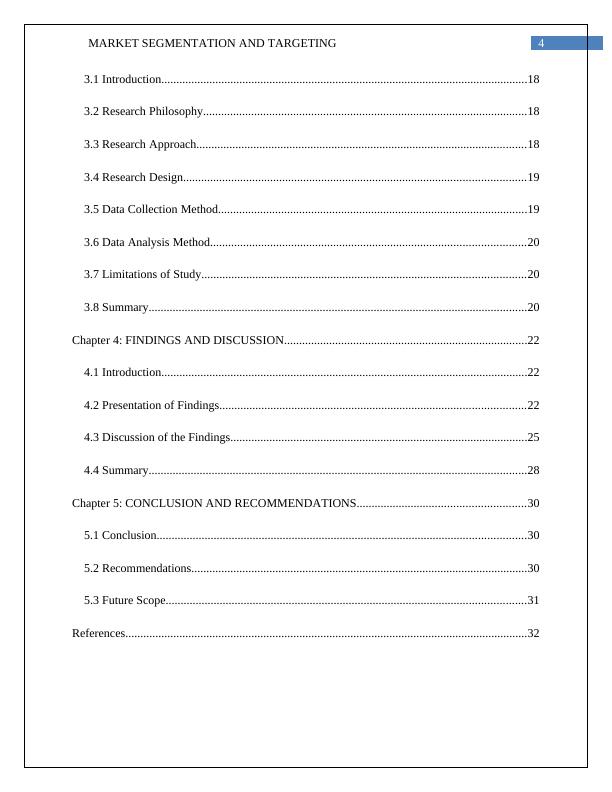
5MARKET SEGMENTATION AND TARGETING
Chapter 1: INTRODUCTION
1.1 Introduction
The researcher in this chapter had highlighted the research aim, problem statement,
objectives, research questions and the other important aspects on the basis of which the entire
study had been conducted. Furthermore, the researcher had also outlined the structure which that
had been followed for the completion of this study.
1.2 Background of the Study
Armstrong et al. (2018) are of the viewpoint that customer segmentation and targeting are
the two most important strategies on which the sales volume and thereby the profitability of the
corporations substantially depend. Adding to this, Matikiti, Roberts-Lombard and Mpinganjira
(2019) have noted that the corporations are required to target a particular segment of the entire
population for the sale of the products or the services offered by them. This can be explained on
the basis of the fact that the success or for that matter the growth of the corporations substantially
depends on the effectiveness with which they are being integrate the needs, requirements and the
demands of the customer segment within the products or services offered by them (Zaki Ahmed
& Rodríguez-Díaz, 2020). In addition to these, they also need to take the help of adequate
targeting strategies so as to adequately influence the attitude or for that matter the behavior of the
concerned customer segment while being able to create value for them (Gupta, Venkaiah &
Ammani, 2016). However, at the same time it needs to be said that despite the different benefits
offered by the effective usage of the processes of customer segmentation and targeting it is seen
that there are various corporations which even in the present times do not take the help of these
processes which in turn had adversely affected their sales volume, profitability and also growth
Chapter 1: INTRODUCTION
1.1 Introduction
The researcher in this chapter had highlighted the research aim, problem statement,
objectives, research questions and the other important aspects on the basis of which the entire
study had been conducted. Furthermore, the researcher had also outlined the structure which that
had been followed for the completion of this study.
1.2 Background of the Study
Armstrong et al. (2018) are of the viewpoint that customer segmentation and targeting are
the two most important strategies on which the sales volume and thereby the profitability of the
corporations substantially depend. Adding to this, Matikiti, Roberts-Lombard and Mpinganjira
(2019) have noted that the corporations are required to target a particular segment of the entire
population for the sale of the products or the services offered by them. This can be explained on
the basis of the fact that the success or for that matter the growth of the corporations substantially
depends on the effectiveness with which they are being integrate the needs, requirements and the
demands of the customer segment within the products or services offered by them (Zaki Ahmed
& Rodríguez-Díaz, 2020). In addition to these, they also need to take the help of adequate
targeting strategies so as to adequately influence the attitude or for that matter the behavior of the
concerned customer segment while being able to create value for them (Gupta, Venkaiah &
Ammani, 2016). However, at the same time it needs to be said that despite the different benefits
offered by the effective usage of the processes of customer segmentation and targeting it is seen
that there are various corporations which even in the present times do not take the help of these
processes which in turn had adversely affected their sales volume, profitability and also growth

6MARKET SEGMENTATION AND TARGETING
as well (Sengur & Sengur, 2017). It is in this particular backdrop that the researcher will analyze
the customer segmentation and targeting strategies used by the corporations related to the airline
sector of Africa.
1.3 Problem Statement
According to the official report of Iata.org (2020), the airline industry is one of the main
pillars of the economy of Africa and for the year 2018 the revenue generated by it was more than
$80.8 billion which accounted for approximately 3.6% of the GDP of the concerned continent.
On the other hand, highlighting the importance of this particular industry within the continent of
Africa the report of Aviationbenefits.org (2020) stated that the airline industry offers
employment to more than 6.2 million people of Africa which in turn account for roughly around
1.8% of the entire employed people within Africa. In this relation, it needs to be said that
Ethiopian Airlines, South African Airways, Kenya Airways, TAAG Angola Airlines, Air
Seychelles and others are some of the most important airline companies operational within the
continent of Africa (Njeru, Cheruiyot & Maru, 2019).
However, as per Weforum.org (2020) the important issue arises since it is seen that the
Africans make up 12% of the entire world population however the Africans make up only 2.5%
of the total air passengers of the world. Furthermore, the different airline-corporations in Africa
are struggling to attain even the basic growth when the airline industries of the other continents
or for that matter the nations are booming presently (Njeru, 2019). As a matter of fact, it is seen
that whereas the “low-cost carriers are about one-quarter of all flights” in the other nations of the
world in Africa they contribute less than 10% of the total flights (Iata.org, 2020). In this relation,
it needs to be said that an important reason for the slow growth rate of the airline industry of
Africa can be attributed to the ineffective marketing strategies or for that matter the customer
as well (Sengur & Sengur, 2017). It is in this particular backdrop that the researcher will analyze
the customer segmentation and targeting strategies used by the corporations related to the airline
sector of Africa.
1.3 Problem Statement
According to the official report of Iata.org (2020), the airline industry is one of the main
pillars of the economy of Africa and for the year 2018 the revenue generated by it was more than
$80.8 billion which accounted for approximately 3.6% of the GDP of the concerned continent.
On the other hand, highlighting the importance of this particular industry within the continent of
Africa the report of Aviationbenefits.org (2020) stated that the airline industry offers
employment to more than 6.2 million people of Africa which in turn account for roughly around
1.8% of the entire employed people within Africa. In this relation, it needs to be said that
Ethiopian Airlines, South African Airways, Kenya Airways, TAAG Angola Airlines, Air
Seychelles and others are some of the most important airline companies operational within the
continent of Africa (Njeru, Cheruiyot & Maru, 2019).
However, as per Weforum.org (2020) the important issue arises since it is seen that the
Africans make up 12% of the entire world population however the Africans make up only 2.5%
of the total air passengers of the world. Furthermore, the different airline-corporations in Africa
are struggling to attain even the basic growth when the airline industries of the other continents
or for that matter the nations are booming presently (Njeru, 2019). As a matter of fact, it is seen
that whereas the “low-cost carriers are about one-quarter of all flights” in the other nations of the
world in Africa they contribute less than 10% of the total flights (Iata.org, 2020). In this relation,
it needs to be said that an important reason for the slow growth rate of the airline industry of
Africa can be attributed to the ineffective marketing strategies or for that matter the customer
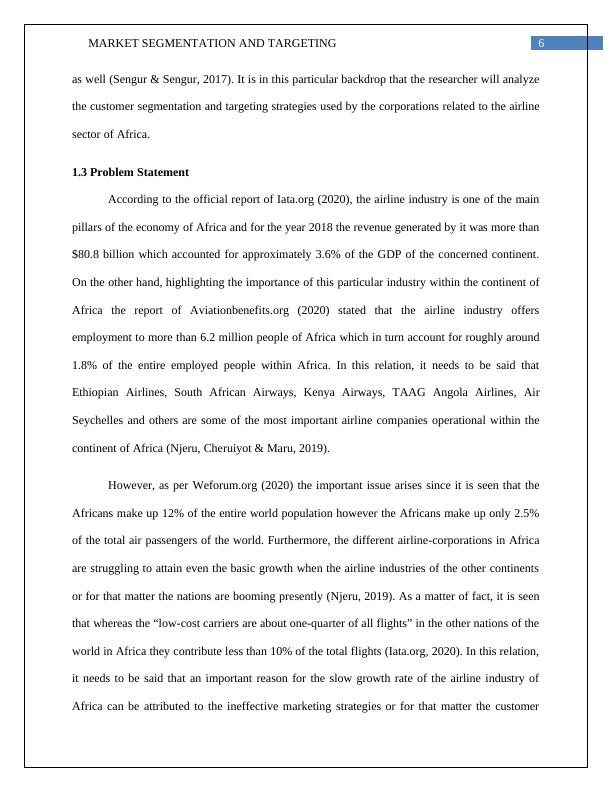
7MARKET SEGMENTATION AND TARGETING
segmentation and targeting strategies which are being used by the different leading airline
corporations of the concerned continent (Parsa et al., 2018). It is this particular problem faced by
the airline sector of Africa that the research would upon.
1.4 Research Aim
The aim of this study is to undertake an analysis of customer segmentation and targeting
strategies used by the airline corporations in Africa by focusing on Ethiopian Airlines, South
African Airways and Kenya Airways.
1.5 Research Objectives
1. To identify the segmentation criteria used by the airline corporations of Africa in the
particular context of Ethiopian Airlines, South African Airways and Kenya Airways
2. To analyze the choices of target markets of the airline corporations of Africa in the
particular context of Ethiopian Airlines, South African Airways and Kenya Airways
3. To evaluate the positioning strategy used by the airline corporations of Africa in the
particular context of Ethiopian Airlines, South African Airways and Kenya Airways
4. To recommend ways through the airline corporations of Africa can improve the process
of customer segmentation used by them in the particular context of Ethiopian Airlines,
South African Airways and Kenya Airways
1.6 Research Questions
1. What is the segmentation criteria used by the airline corporations of Africa in the
particular context of Ethiopian Airlines, South African Airways and Kenya Airways?
2. What are the choices of target markets of the airline corporations of Africa in the
particular context of Ethiopian Airlines, South African Airways and Kenya Airways?
segmentation and targeting strategies which are being used by the different leading airline
corporations of the concerned continent (Parsa et al., 2018). It is this particular problem faced by
the airline sector of Africa that the research would upon.
1.4 Research Aim
The aim of this study is to undertake an analysis of customer segmentation and targeting
strategies used by the airline corporations in Africa by focusing on Ethiopian Airlines, South
African Airways and Kenya Airways.
1.5 Research Objectives
1. To identify the segmentation criteria used by the airline corporations of Africa in the
particular context of Ethiopian Airlines, South African Airways and Kenya Airways
2. To analyze the choices of target markets of the airline corporations of Africa in the
particular context of Ethiopian Airlines, South African Airways and Kenya Airways
3. To evaluate the positioning strategy used by the airline corporations of Africa in the
particular context of Ethiopian Airlines, South African Airways and Kenya Airways
4. To recommend ways through the airline corporations of Africa can improve the process
of customer segmentation used by them in the particular context of Ethiopian Airlines,
South African Airways and Kenya Airways
1.6 Research Questions
1. What is the segmentation criteria used by the airline corporations of Africa in the
particular context of Ethiopian Airlines, South African Airways and Kenya Airways?
2. What are the choices of target markets of the airline corporations of Africa in the
particular context of Ethiopian Airlines, South African Airways and Kenya Airways?
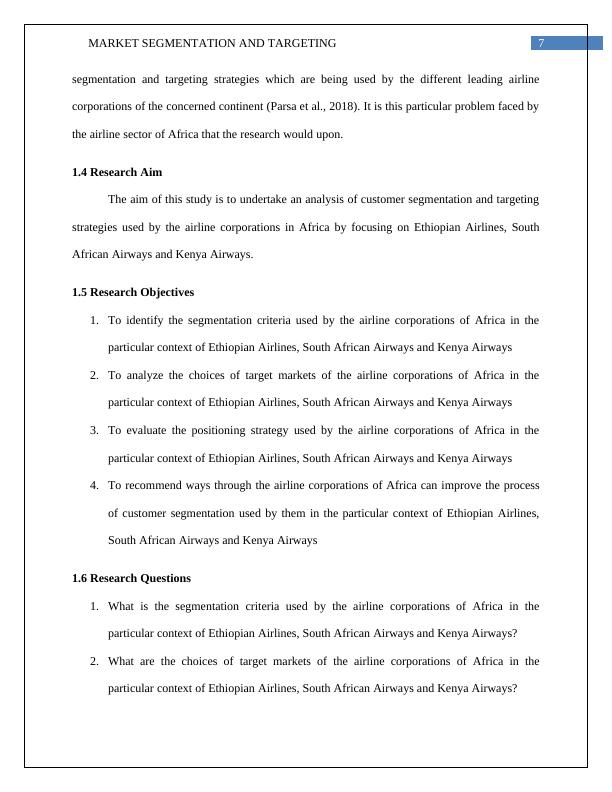
End of preview
Want to access all the pages? Upload your documents or become a member.
Related Documents
Business Research Proposallg...
|11
|2335
|62
Air Algerie: A Study on Performance and Restructuring Planlg...
|56
|16442
|95
Air Algerie: A Study on Performance, Costs and Solutionslg...
|46
|11440
|413
Competition in Aviation Management for British Airways in UKlg...
|7
|1372
|284
The Role of Leadership on the Retention of Millennial Employees in the South African Retail Sectorlg...
|68
|21999
|472
Impact of Work Force Development on the Customer Servicelg...
|53
|14916
|47
